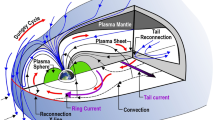Abstract
Exposed to space plasma and solar radiation, electrostatic potential may build up in the lunar regolith, leading to a wealth of dust phenomena, including levitation, oscillation, and transport over the surface. Based on plasma sheath theory, the global near-surface plasma environment is modeled, and the dynamics of charged dust are investigated. Results show that sub-micron sized dust particles can be levitated by the electric field over the surface, forming a dust belt that changes in position and thickness depending on the solar zenith angle. On the dayside of the Moon, stably levitated particles are about ten times smaller, and collect in a thinner belt closer to the surface than do those on the nightside. Although the size and charge of stably levitated dust particles are dependent on ambient plasma conditions, initial charge and velocity, which are closely related to the dynamics of dust particles including charging, oscillation, and damping, will determine whether, or not, a particle can attain stable levitation. Horizontal electrostatic dust transport near to the terminator region may lead to net deposition of dust from the dark into the sunlit hemisphere. Finally, because of different charging processes that result due to rotation of the Moon, before precipitation, dust particles in the dusk terminator region may be transported much longer distances and oscillate to much higher altitude than these in the dawn terminator.
Similar content being viewed by others
References
Anuar A K. 2013. A study of dusty plasma environment. Doctoral Dissertation. Lancashire: Lancaster University
Anuar A K, Honary F, Hapgood M, Roussel J F. 2013. Three-dimensional simulation of dust charging and dusty plasma using SPIS. J Geophys Res Space Phys, 118: 6723–6735
Berg O E, Wolf H, Rhee J. 1976. Lunar soil movement registered by the Apollo 17 cosmic dust experiment. In: Elsässer H, Fechtig H, eds. Interplanetary Dust and Zodiacal Light. New York: Springer-Verlag. 233–237
Colwell J E, Batiste S, Horányi M, Robertson S, Sture S. 2007. Lunar surface: Dust dynamics and regolith mechanics. Rev Geophys, 45: RG2006
Colwell J, Gulbis A, Horanyi M, Robertson S. 2005. Dust transport in photoelectron layers and the formation of dust ponds on Eros. Icarus, 175: 159–169
Freeman J W, Ibrahim M. 1975. Lunar electric fields, surface potential and associated plasma sheaths. The Moon, 14: 103–114
Guernsey R L, Fu J H M. 1970. Potential distribution surrounding a photoemitting, plate in a dilute plasma. J Geophys Res, 75: 3193–3199
Halekas J S, Bale S D, Mitchell D L, Lin R P. 2005. Electrons and magnetic fields in the lunar plasma wake. J Geophys Res, 110: A07222
Manka R H. 1973. Plasma and potential at the lunar surface. In: Grad, eds. Photon and Particle Interaction with Surfaces in Space. Dordrecht-Holland: DReidel Publishing Company. 347–361
Nishino M N, Maezawa K, Fujimoto M, Saito Y, Yokota S, Asamura K, Tanaka T, Tsunakawa H, Matsushima M, Takahashi F, Terasawa T, Shibuya H, Shimizu H. 2009a. Pairwise energy gain-loss feature of solar wind protons in the near-Moon wake. Geophys Res Lett, 36: L12108
Nishino M N, Fujimoto M, Maezawa K, Saito Y, Yokota S, Asamura K, Tanaka T, Tsunakawa H, Matsushima M, Takahashi F, Terasawa T, Shibuya H, Shimizu H. 2009b. Solar-wind proton access deep into the near-Moon wake. Geophys Res Lett, 36: L16103
Nitter T, Havnes O, Melandsø F. 1998. Levitation and dynamics of charged dust in the photoelectron sheath above surfaces in space. J Geophys Res, 103: 6605–6620
Nitter T, Aslaksen T K, Melandso F, Havnes O. 1994. Levitation and dynamics of a collection of dust particles in a fully ionized plasma sheath. IEEE Trans Plasma Sci, 22: 159–172
Nitter T, Havnes O. 1992. Dynamics of dust in a plasma sheath and injection of dust into the plasma sheath above Moon and asteroidal surfaces. Earth Moon Planet, 56: 7–34
Poppe A, Horányi M. 2010. Simulations of the photoelectron sheath and dust levitation on the lunar surface. J Geophys Res, 115: A08106
Rennilson J J, Criswell D R. 1974. Surveyor observations of lunar horizonglow. Earth Moon Planets, 10: 121–142
Whipple E C. 1981. Potentials of surfaces in space. Rep Prog Phys, 44: 1197–1250
Willis R F, Anderegg M, Feuerbacher B, Fitton B. 1973. Photoemission and secondary electron emission from lunar surface material. In: Gerard R J L, eds. Photon and Particle Interactions with Surfaces in Space. New York: Springer. 369–387
Zook H A, Potter A E, Cooper B L. 1995. The lunar dust exosphere and Clementine lunar horizon glow. Lunar Planet Sci, 26: 1577–1578
Author information
Authors and Affiliations
Corresponding author
Rights and permissions
About this article
Cite this article
Li, L., Zhang, Y., Zhou, B. et al. Dust levitation and transport over the surface of the Moon. Sci. China Earth Sci. 59, 2053–2061 (2016). https://doi.org/10.1007/s11430-016-0015-6
Received:
Accepted:
Published:
Issue Date:
DOI: https://doi.org/10.1007/s11430-016-0015-6




